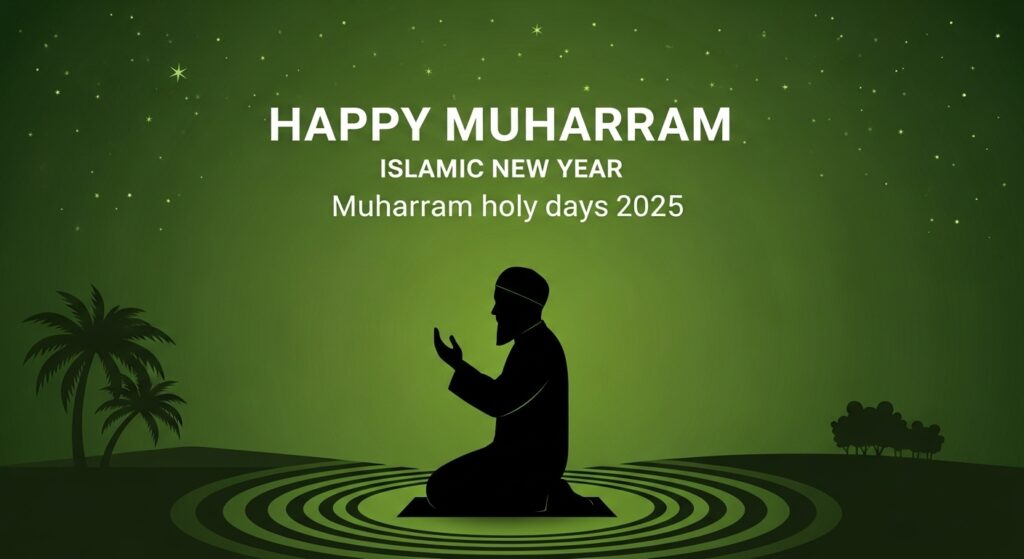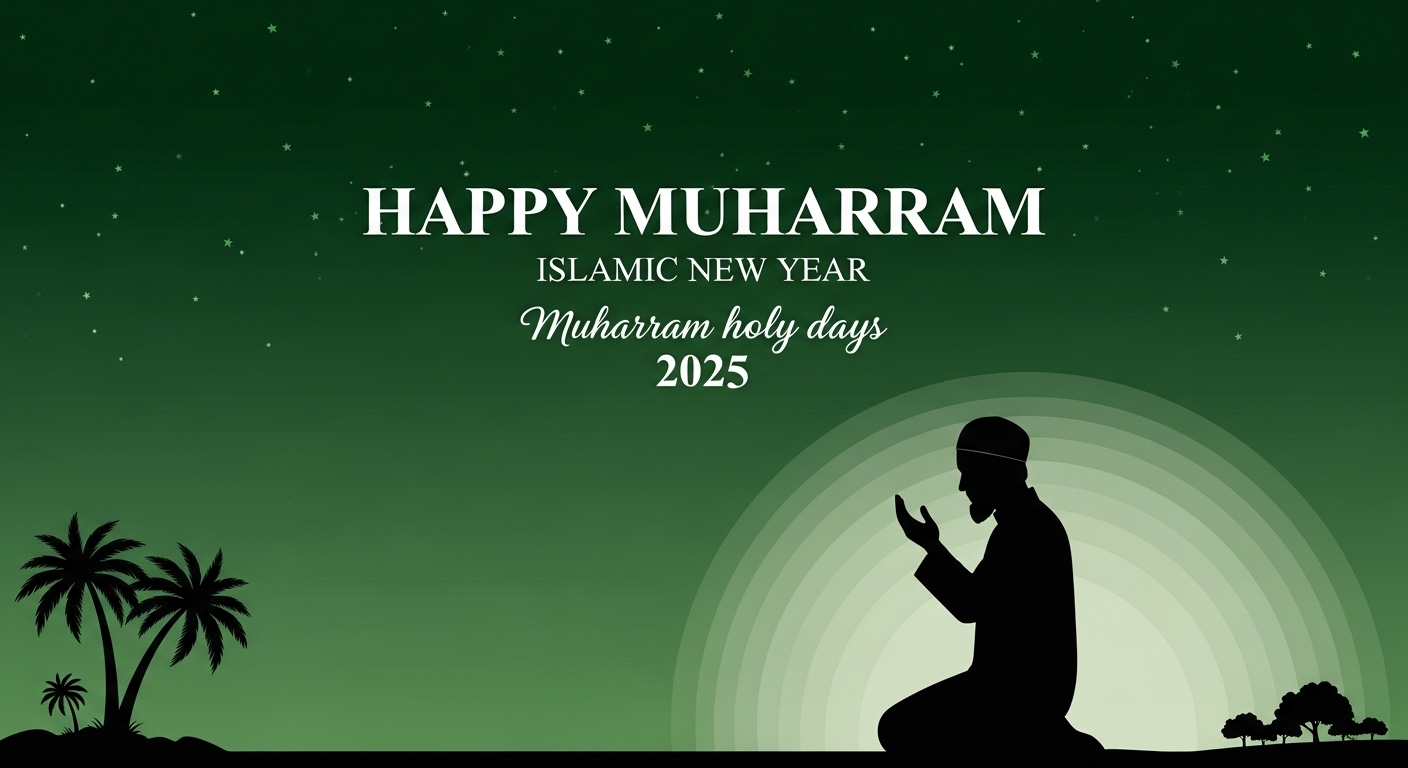Explore the profound meaning of Muharram holy days 2025, including the start of Hijri 1447 AH and Ashura (July 5). Understand its spiritual importance, diverse observances, and the enduring legacy of Karbala.
Table of Contents
Muharram Holy Days 2025: A Deep Dive into Islamic Remembrance and Reflection
Muharram holy days 2025 mark a period of profound spiritual significance for Muslims worldwide. As the first month of the Islamic Hijri calendar, Muharram is not just the ushering in of a new year, but a time steeped in history, devotion, and solemn remembrance. While all Muslims observe the sanctity of Muharram, its observance takes on particular significance for Shia Muslims, who mourn the martyrdom of Imam Hussein (AS) and his companions at the Battle of Karbala. Understanding the various facets of Muharram holy days 2025 provides insight into Islamic history, tradition, and the enduring power of faith.
The Dawn of a New Islamic Year: Muharram 1447 AH
The Islamic calendar, a lunar calendar, dictates that the start of each month is dependent on the sighting of the new crescent moon. For 2025, the Muharram holy days officially commenced with the sighting of the moon on Wednesday, June 25, 2025, in Saudi Arabia. This means that Thursday, June 26, 2025, marks the 1st of Muharram 1447 AH, ushering in the new Islamic year. This first day, while not associated with specific celebratory rituals, is a time for reflection on the past year and setting intentions for spiritual growth in the new one. Many Muslims use this day to review their deeds, seek repentance, and renew their commitment to Islamic principles.
The Sacredness of Muharram: A Month of Peace
Muharram holds a unique position as one of the four sacred months in Islam (alongside Rajab, Dhul Qa’dah, and Dhul Hijjah). During these months, warfare and conflict are strictly prohibited, emphasizing peace, tranquility, and devotion. This inherent sanctity underscores the spiritual importance of Muharram holy days. The word “Muharram” itself means “forbidden” or “sacred,” highlighting its revered status in Islamic tradition. It is a time when good deeds are believed to be multiplied in reward, encouraging Muslims to engage in increased acts of worship, charity (sadaqah), and reflection.
The Day of Ashura 2025: A Pivotal Date
Within the Muharram holy days, the 10th of Muharram, known as Ashura, is the most significant day. For 2025, the Day of Ashura will fall on Saturday, July 5, 2025. Ashura is a day of profound historical and religious importance for both Sunni and Shia Muslims, though observed with differing practices and emphasis.
For Sunni Muslims, Ashura is primarily known as the day Allah (SWT) saved Prophet Musa (Moses) and the Israelites from Pharaoh by parting the Red Sea. It is also believed to be the day Prophet Nuh (Noah) left the Ark. Prophet Muhammad (PBUH) is reported to have strongly encouraged fasting on this day, often recommending fasting on the 9th and 10th (Tasu’a and Ashura) or the 10th and 11th of Muharram to differentiate from Jewish practices. Fasting on Ashura is seen as an act of gratitude to Allah and a means of expiating sins from the previous year.
For Shia Muslims, Ashura is a solemn day of immense grief and mourning, commemorating the martyrdom of Imam Hussein (AS), the grandson of Prophet Muhammad (PBUH), along with his family and companions, in the Battle of Karbala in 61 AH (680 CE). This tragic event is central to Shia identity and remembrance during Muharram holy days.
The Tragedy of Karbala: A Defining Moment
The Battle of Karbala is the cornerstone of Shia observance during Muharram holy days. It occurred on the 10th of Muharram in 61 AH, in the desert plains of Karbala (modern-day Iraq). Imam Hussein (AS) had set out from Mecca with a small group of family members and loyal companions after refusing to pledge allegiance to Yazid I, the Umayyad caliph, whom he considered an illegitimate and tyrannical ruler.
Upon reaching Karbala, Imam Hussein’s caravan was surrounded by a much larger Umayyad army. They were cut off from water for several days, leading to immense suffering. Despite being heavily outnumbered (Imam Hussein’s group comprised about 72 fighting men against an army estimated to be thousands strong), Imam Hussein (AS) and his companions bravely resisted, choosing honorable death over submission to injustice. The battle culminated in the brutal martyrdom of Imam Hussein (AS) and almost all of his male companions and family members, including his infant son, Ali Asghar. The women and children were taken as captives to Damascus.
The tragedy of Karbala, commemorated during Muharram holy days, is seen by Shia Muslims as the ultimate sacrifice for truth, justice, and the preservation of authentic Islamic values against oppression and corruption. It symbolizes the eternal struggle between good and evil, and the courage to stand for what is right, regardless of the consequences.
Observances During Muharram Holy Days
The ways in which Muslims observe Muharram holy days vary significantly between Shia and Sunni communities, reflecting their distinct historical interpretations and theological emphases.
Shia Muslim Observances:
For Shia Muslims, the first ten days of Muharram, culminating on Ashura, are a period of intense mourning and remembrance. The rituals observed during these Muharram holy days are designed to express profound grief and solidarity with Imam Hussein’s sacrifice. These typically include:
- Majalis (Mourning Gatherings): Throughout the first ten nights and days, Shia Muslims attend majalis, religious gatherings held in mosques, imambargahs, or private homes. During these gatherings, scholars and orators narrate the events of Karbala, recounting the suffering of Imam Hussein (AS) and his companions. Elegies (marsiya) and lamentations (nawha) are recited, often accompanied by rhythmic chest-beating (matam or sina-zani) to express sorrow.
- Wearing Black: Many Shia Muslims wear black clothing as a symbol of mourning during the entire month of Muharram and sometimes Safar (the second Islamic month).
- Processions (Juloos/Matam): On Ashura, and sometimes Tasu’a (9th Muharram), large processions take place in Shia-majority areas around the world. Participants march, often barefoot, reciting lamentations and performing matam, openly expressing their grief and solidarity. Some processions also feature symbolic replicas of Imam Hussein’s shrine or bier, known as Taziya.
- Avoiding Celebrations: Shia Muslims typically avoid any form of celebration, joyous events, or worldly indulgences during these Muharram holy days. Marriages are usually not solemnized, and new clothes or festivities are generally shunned.
- Feeding the Poor: Giving food to the poor (Niaz) is a common practice, particularly in the name of Imam Hussein (AS) and his companions, symbolizing generosity and community spirit.
- Self-Flagellation (Controversial): In some communities, extreme forms of self-flagellation, involving self-inflicted bloodshed (zanjeer zani or tatbir), are practiced. However, these practices are highly controversial among Shia scholars, condemned by many, and often outlawed in various communities and countries. The emphasis among the majority is on spiritual remembrance and less extreme forms of mourning.

Sunni Muslim Observances:
While Sunni Muslims also hold Imam Hussein (AS) in high regard and acknowledge the tragedy of Karbala, their observance of Muharram holy days generally differs from the intense mourning practices of Shia Muslims. For Sunnis, the focus on Ashura is primarily on:
- Fasting: As mentioned, fasting on the 9th and 10th of Muharram or the 10th and 11th is highly recommended (Sunnah). This is seen as following the practice of Prophet Muhammad (PBUH) and seeking forgiveness from Allah.
- Prayer and Remembrance: Sunni Muslims engage in increased prayer, recitation of the Quran, and remembrance of Allah during this sacred month.
- Charity: Giving to charity is also encouraged.
- Reflection: Muharram is viewed as a time for personal spiritual reflection and seeking closeness to Allah.
It is important to note that some Sunni communities, particularly in South Asia, have historically participated in certain cultural mourning practices alongside Shia Muslims, though this is not universal across all Sunni sects. The common thread for all Muslims during Muharram holy days is the recognition of Muharram as a sacred month and a time for heightened devotion.
The Enduring Legacy of Imam Hussein (AS)
The martyrdom of Imam Hussein (AS) during the Muharram holy days continues to resonate across centuries, inspiring millions globally. His stand against injustice, his unwavering commitment to principles, and his ultimate sacrifice have made him a timeless symbol of courage, resilience, and moral integrity. His legacy transcends sectarian divides, serving as a powerful reminder for all humanity to:
- Stand for Justice: Imam Hussein’s refusal to compromise his principles in the face of tyranny teaches the importance of standing up for justice and truth, even against overwhelming odds.
- Sacrifice for Beliefs: His willingness to sacrifice everything, including his life and family, for the sake of higher ideals demonstrates the ultimate commitment to one’s beliefs.
- Moral Courage: The Battle of Karbala is a testament to moral courage, highlighting that true strength lies not in military might, but in the righteousness of one’s cause.
- Spiritual Resistance: Imam Hussein’s movement was not merely political; it was a spiritual resistance against the moral decay and corruption threatening the essence of Islam.
The lessons from Karbala, revisited during Muharram holy days, are universal. They encourage individuals to reflect on their own lives, to oppose oppression in all its forms, and to strive for a more just and equitable society.
Muharram in a Global Context
The observance of Muharram holy days varies culturally and geographically, but the core themes of remembrance, sacrifice, and spiritual introspection remain constant. In many Muslim-majority countries, particularly those with significant Shia populations like Iran, Iraq, Lebanon, and parts of South Asia, public holidays are declared around Ashura. Major cities witness large-scale processions and gatherings, attracting millions of participants.
Even in countries with smaller Muslim communities, the spirit of Muharram is maintained through private gatherings, religious lectures, and acts of charity. The focus remains on educating younger generations about the historical significance of Karbala and the timeless lessons derived from Imam Hussein’s sacrifice.
Conclusion: A Time for Reflection and Renewal
As Muharram holy days 2025 dawn, marking the beginning of the Islamic year 1447 AH, Muslims around the world will engage in various forms of remembrance and worship. For all, it is a sacred month, a time to increase devotion, seek forgiveness, and reflect on one’s spiritual journey. For Shia Muslims, it is a deeply solemn period of mourning, commemorating the supreme sacrifice of Imam Hussein (AS) and his companions at Karbala – a tragedy that continues to inspire resistance against injustice and a profound commitment to Islamic values.
The lessons learned during Muharram holy days – of courage, sacrifice, and upholding truth – are timeless. They serve as a powerful annual reminder for Muslims to strive for justice, uphold righteousness, and live a life guided by faith and moral integrity. This sacred month is not just a historical commemoration but a continuous source of spiritual renewal and moral fortitude.




